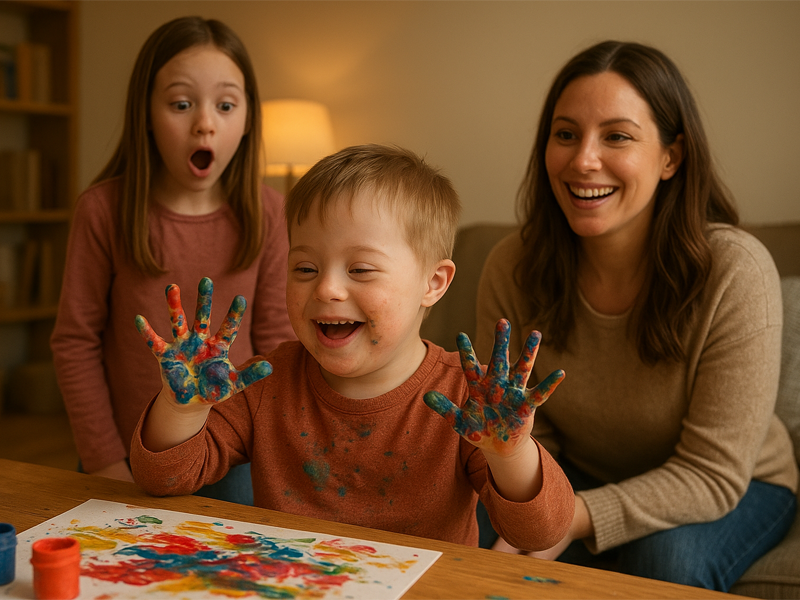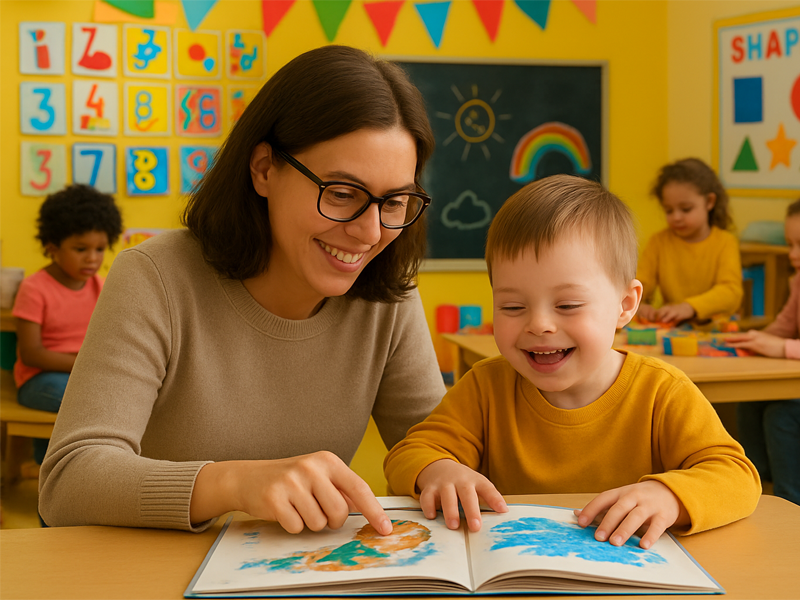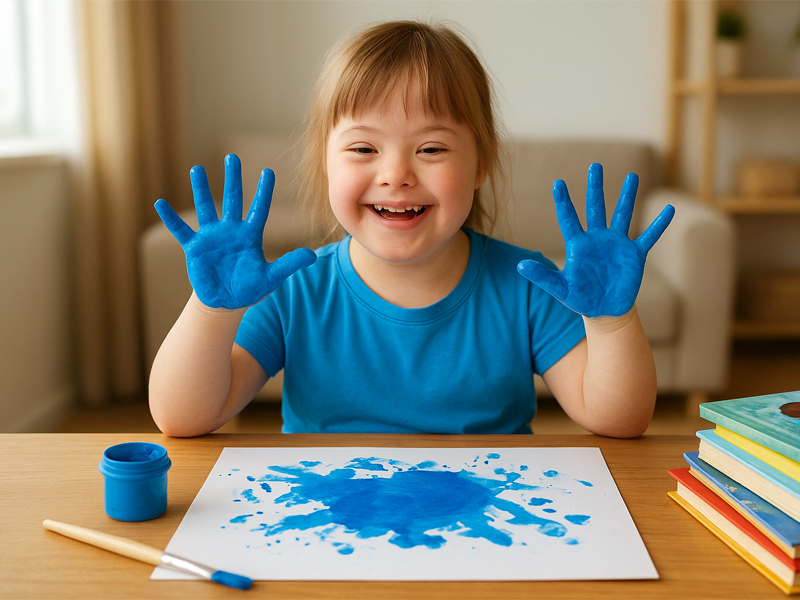Classrooms are where empathy, understanding, and acceptance begin. For many young children, school is often the first place where they meet classmates who learn, speak, or grow differently from they do. This is why intentional representation in children’s literature matters. Shelley Smith Adams wrote her book with a clear purpose: to show that children with Down syndrome are not defined by their diagnosis. They giggle, explore, play, get creative, and yes, get into the same messy fun as any other child. When a teacher introduces a Down syndrome awareness picture book like this into the classroom, they are opening the door to conversations that normalize inclusion in a gentle, joyful way.
In Shelley Adams’ “Coley Bear’s Blue-Tastic Day!”, Cole is simply being a child. He sees painting happening on television and wants to try it himself. What happens next is something every teacher and parent can relate to—blue paint everywhere, laughter, curiosity, and a lovable mess. The book doesn’t highlight differences; it highlights childhood. It shows that children with Down syndrome have imaginations, humor, and a sense of adventure, just like all children. This message makes the book a valuable resource for classrooms that believe in teaching acceptance through real-life, relatable moments.
1. Normalizing Real Childhood Moments
The author’s goal is not to point out what makes kids with Down syndrome different, but to highlight the reasons they are the same. When a teacher reads this story aloud, the message becomes easy for students to understand. Instead of discussing medical terms or limitations, the class experiences the pure joy of childhood. Students laugh at the paint splatters, enjoy the silliness, and relate to the story. The lesson becomes natural—kids are kids.
This is the power of inspirational books about kids with down syndrome—stories grounded in real childhood experiences that help students see beyond differences. Through these picture books, children learn that their classmate with Down syndrome doesn’t need to be treated differently. They might need a little help or learn at a different pace, but they share the same love for fun, adventure, and creativity as everyone else.
2. Moving from Sympathy to Respect
One of the challenges educators face is that children sometimes feel “sorry” for classmates with disabilities without understanding the full picture. This book redirects that mindset. Cole doesn’t need pity—he needs paint paper. He doesn’t need to be talked down to—he needs space to explore, make mistakes, and learn. Teachers can use this moment as a discussion point:
- What did Cole do that was funny?
- Have you ever made a mess, too?
- Would you want to paint with Cole?
These questions create connection, not separation.
3. A Positive Tool for Class Culture
Teachers often introduce literature to build classroom values. Books about kindness, sharing, and friendship are common. A book like this fits right in, not because it focuses on disability, but because it reinforces what inclusion should look like in everyday life. It sends a message that students with Down syndrome belong—not as guests, but as classmates, friends, and equal participants.
Educators who use Down syndrome books understand the importance of representation that feels natural and uplifting. This particular story aligns perfectly with that mission.
4. Support for New Families and School Communities
Many teachers have had students with Down syndrome in their classroom for the first time. Sometimes, families are new to the diagnosis and feel overwhelmed. Literature can help. When teachers share relatable stories with parents, the emotional impact is powerful. Shelley Smith Adams created this book so families can see hope and happiness, not fear. Parents reading this story realize that their child will paint, laugh, try new things, make messes, and live a full childhood.
For that reason, this book is not only valuable in classrooms—it also belongs in school libraries as one of the best books for families with Down syndrome kids and an essential read for teachers who want to better support their students. It offers parents reassurance that childhood is still joyful, exciting, and full of possibility, helping families see that their children will grow, learn, and thrive in their own beautiful ways.
5. Encouraging Inclusive Activities
After reading, teachers can encourage activities that mirror the story:
- Finger painting
- Talking about favorite colors
- Expressing creativity through art
- Drawing moments where they felt proud
This allows students to connect to Cole’s experience. Inclusion becomes action—not just a discussion.
6. A Book with a Purpose
Shelley Smith Adams did not write this book as a medical explanation or educational manual. She wrote it with heart. She wanted to make sure families and children see that kids with Down syndrome are not defined by diagnosis, but by personality, imagination, and love. When teachers choose a Down syndrome awareness picture book like this, they are promoting dignity and respect without lecturing or forcing lessons upon their students. The message comes through naturally.
This story also deserves a place among inspirational books about kids with down syndrome, as it helps children show their siblings, cousins, and friends that their loved one fits perfectly into everyday childhood moments. It stands proudly among picture books about Down syndrome that celebrate joy, inclusion, and the beauty of ordinary life—reminding readers that every child’s story is inspiring in its own way.
Why This Matters
Representation is not about pointing out differences—it is about removing fear, replacing stereotypes, and showing real life. When a child with Down syndrome sees themselves in a story, confidence grows. When other students see them in a story, empathy becomes reality. This is why classrooms need books like these. It is not about teaching children how to treat someone “special.” It is about showing them that every child deserves the same laughter, the same paint, and the same fun memories.
Teachers who choose a Down syndrome awareness picture book help build a world where all children feel included, welcomed, and understood. And that is the kind of classroom every child deserves.




